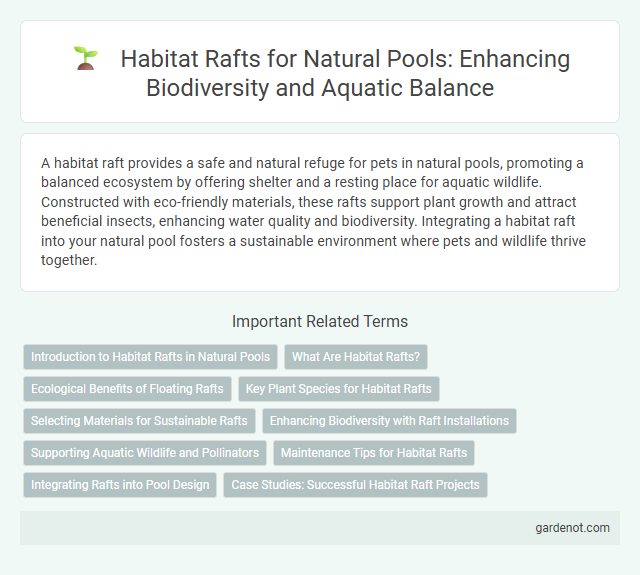A habitat raft provides a safe and natural refuge for pets in natural pools, promoting a balanced ecosystem by offering shelter and a resting place for aquatic wildlife. Constructed with eco-friendly materials, these rafts support plant growth and attract beneficial insects, enhancing water quality and biodiversity. Integrating a habitat raft into your natural pool fosters a sustainable environment where pets and wildlife thrive together.
Introduction to Habitat Rafts in Natural Pools
Habitat rafts in natural pools create floating ecosystems that support biodiversity by offering shelter and breeding grounds for aquatic plants, insects, and amphibians. These structures enhance water quality by promoting nutrient cycling and providing areas for beneficial microorganisms to thrive. Integrating habitat rafts into natural pools fosters balanced aquatic environments and boosts ecosystem resilience.
What Are Habitat Rafts?
Habitat rafts are floating structures designed to create natural habitats for aquatic wildlife in natural pools and water bodies. These rafts support plant growth and provide shelter for fish, insects, and amphibians, enhancing biodiversity and water quality through natural filtration. Constructed from eco-friendly materials, habitat rafts help stabilize ecosystems and promote a balanced aquatic environment.
Ecological Benefits of Floating Rafts
Habitat rafts in natural pools provide essential habitats for aquatic plants and animals, enhancing biodiversity by supporting fish, amphibians, and beneficial microorganisms. These floating rafts improve water quality through natural filtration and oxygenation, reducing algae growth and promoting a balanced ecosystem. Their ability to create microhabitats contributes to the stabilization of local wildlife populations and strengthens the overall ecological resilience of natural pools.
Key Plant Species for Habitat Rafts
Key plant species for habitat rafts in natural pools include native aquatic plants like water lilies (Nymphaea spp.), cattails (Typha spp.), and sedges (Carex spp.), which provide crucial shelter and breeding grounds for aquatic wildlife. These plants enhance water quality by filtering pollutants and stabilizing sediments, promoting biodiversity within the pool ecosystem. Incorporating floating vegetation such as water hyacinth (Eichhornia crassipes) and duckweed (Lemna minor) supports microhabitats for insects, amphibians, and small fish.
Selecting Materials for Sustainable Rafts
Selecting materials for sustainable habitat rafts involves prioritizing eco-friendly options like reclaimed wood, bamboo, and biodegradable composites that minimize environmental impact. Using non-toxic, water-resistant coatings ensures durability while protecting aquatic life in the natural pool ecosystem. Incorporating lightweight, sturdy materials enhances buoyancy and stability, promoting a thriving habitat for local wildlife.
Enhancing Biodiversity with Raft Installations
Habitat rafts in natural pools create microhabitats that support diverse aquatic species, including amphibians, insects, and beneficial plants. These floating structures improve oxygenation and provide shelter, promoting ecosystem balance and increasing overall biodiversity. Strategic placement of habitat rafts encourages species colonization and enhances the natural filtration process within the pool environment.
Supporting Aquatic Wildlife and Pollinators
Habitat rafts in natural pools enhance biodiversity by creating floating ecosystems that support aquatic wildlife such as amphibians, insects, and small fish. These rafts offer shelter and breeding grounds while promoting pollinator activity by featuring native wetland plants that attract bees, butterflies, and other beneficial insects. This integration fosters a balanced aquatic habitat, improving water quality and ecological resilience.
Maintenance Tips for Habitat Rafts
Regular removal of debris and algae from the habitat raft ensures optimal water quality and prevents blockages in natural pool ecosystems. Inspecting the raft's structural integrity and securely reattaching loose components promotes stability and supports aquatic plant growth. Seasonal cleaning and repositioning in shaded areas help maintain balanced oxygen levels and protect biodiversity in natural pools.
Integrating Rafts into Pool Design
Integrating habitat rafts into natural pool design enhances biodiversity by providing floating platforms that support aquatic plants and wildlife. These rafts improve water quality through natural filtration while creating microhabitats for insects, amphibians, and birds. Strategic placement and vegetation selection on rafts ensure optimal ecological balance and aesthetic harmony within the pool ecosystem.
Case Studies: Successful Habitat Raft Projects
Case studies of successful habitat raft projects demonstrate significant improvements in aquatic biodiversity by providing stable environments for fish and invertebrate populations. Projects such as the Thames River Habitat Rafts in London and the Chesapeake Bay Floating Wetlands in Maryland have shown enhanced water quality and increased native plant growth. These rafts support ecosystem restoration by creating refuge areas and promoting species diversity within natural pool settings.
Habitat raft Infographic

 gardenot.com
gardenot.com